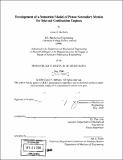Development of a numerical model of piston secondary motion for internal combustion engines
Author(s)
McNally, Conor P. (Conor Peter), 1975-
DownloadFull printable version (6.521Mb)
Other Contributors
Massachusetts Institute of Technology. Dept. of Mechanical Engineering.
Advisor
Tian Tian.
Terms of use
Metadata
Show full item recordAbstract
The reciprocating motion of the piston of an internal combustion engine in the vertical plane is referred to as its primary motion, and it is this primary motion that produces power in the engine. Due to the fact that there is a clearance between the piston and the liner, and that certain forces on the piston have components in the horizontal direction, there exists some lateral motion of the piston and also some rotational motion about the wrist pin axis. This motion is referred to as secondary motion. Secondary motion has significant implications for oil transport past the piston ring-pack, engine friction and engine noise. For these reasons a comprehensive numerical model of secondary motion is a valuable tool for engine designers and development engineers. This work involves the development of a comprehensive and robust computer model of piston secondary motion, which can be easily run on a desktop computer. The model is applicable to both conventional mono-piston assemblies and also to articulated piston assemblies. The modeling approach involves treating the piston assembly as a set of independent rigid bodies, and formulating and solving the equations of motion for each body. The hydrodynamic skirt-liner interaction force is computed by solving the Reynolds equation for the oil film and integrating the computed pressure. This essentially one dimensional calculation is performed at several circumferential locations on the piston, and the results are integrated to yield a single force in the main thrust-anti thrust direction. The model is first developed with a basic form of this hydrodynamic calculation, which is later improved to include a solution for the wetted region and a complete pressure distribution on the piston. Results using both forms of the model are compared and analyzed, and the final model is used to perform several parametric studies involving various engine operating parameters.
Description
Thesis (S.M.)--Massachusetts Institute of Technology, Dept. of Mechanical Engineering, 2000. Includes bibliographical references (leaves 100-101).
Date issued
2000Department
Massachusetts Institute of Technology. Department of Mechanical EngineeringPublisher
Massachusetts Institute of Technology
Keywords
Mechanical Engineering.